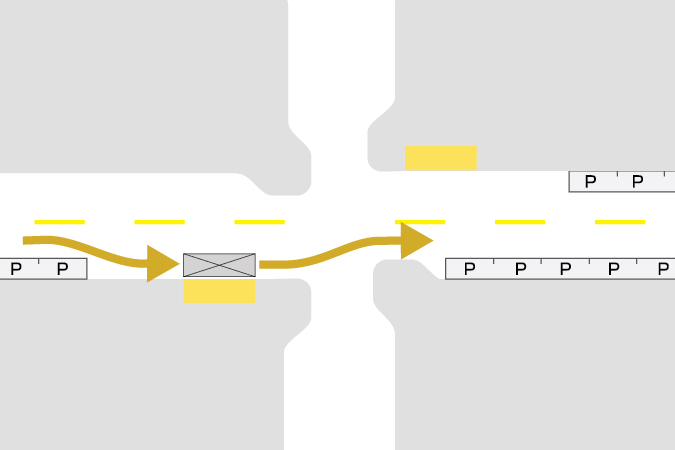
Near-side pull-out stops favor motor vehicle traffic flow, and confer limited benefits to transit operations. At high traffic volume locations, the near-side stop functions as a right-turn lane when buses are not present.
When used as queue jump lanes with active transit signal priority, near-side stops can enhance operations at high-traffic-volume intersections.
Buses may have significant difficulty re-entering the traffic stream. Signal measures, such as upstream early red phases, can address this issue.
Near-side stops can be used to facilitate transfer between two intersecting routes.
A near-side pull-out stop should be set back from the crosswalk at least 15 feet. Stops located just before the crosswalk can block the visibility of pedestrians.
Except for transfer points, near-side pull-out stops are not generally preferred on multi-lane streets, but may be applied if a major near-side destination exists, or if problematic conditions such as driveways or missing sidewalks exist at the far-side location.
Read More+
Near-side stops may facilitate destination access, boarding during red signal phases, and legible transfers in certain contexts, but generally favor vehicle traffic.
KFH Group. Guidelines for the Design and Placement of Transit Stops. Washington Metropolitan Area Transit Authority, Washington, DC (2009).
In cities with yield-to-bus/yield-to-streetcar rules and high compliance, broader implementation of near-side pull-out stops is possible.
Place near-side stops close enough to the intersection that right-turning vehicles cannot merge in front of the bus.
Near-side stops present challenges at intersections with transit route turns. If buses are required to turn right from the curbside, provide a signal phase for the transit movement, or design the cross street to accommodate a vehicle sweeping across the second lane or the oncoming lane.